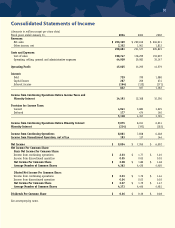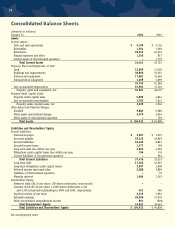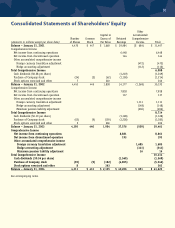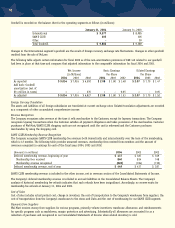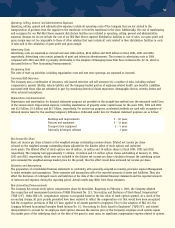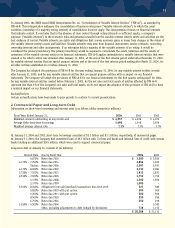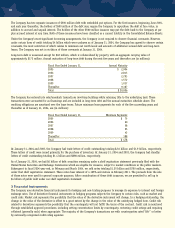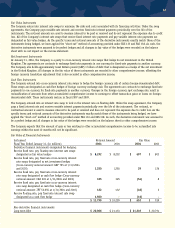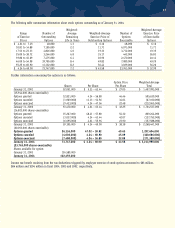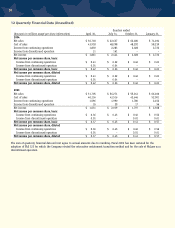Walmart 2004 Annual Report Download - page 44
Download and view the complete annual report
Please find page 44 of the 2004 Walmart annual report below. You can navigate through the pages in the report by either clicking on the pages listed below, or by using the keyword search tool below to find specific information within the annual report.
42
The Company has two separate issuances of $500 million debt with embedded put options. For the first issuance, beginning June 2001,
and each year thereafter, the holders of $500 million of the debt may require the Company to repurchase the debt at face value, in
addition to accrued and unpaid interest. The holders of the other $500 million issuance may put the debt back to the Company at par
plus accrued interest at any time. Both of these issuances have been classified as a current liability in the Consolidated Balance Sheets.
Under the Company’s most significant borrowing arrangements, the Company is not required to observe financial covenants. However,
under certain lines of credit totaling $4 billion which were undrawn as of January 31, 2004, the Company has agreed to observe certain
covenants, the most restrictive of which relates to minimum net worth levels and amounts of additional secured debt and long-term
leases. The Company was not in violation of these covenants at January 31, 2004.
Long-term debt is unsecured except for $62 million, which is collateralized by property with an aggregate carrying value of
approximately $172 million. Annual maturities of long-term debt during the next five years and thereafter are (in millions):
Fiscal Year Ended January 31, Annual Maturity
2005 $ 2,904
2006 2,813
2007 2,293
2008 1,572
2009 1,037
Thereafter 9,387
Total $ 20,006
The Company has entered into sale/leaseback transactions involving buildings while retaining title to the underlying land. These
transactions were accounted for as financings and are included in long-term debt and the annual maturities schedule above. The
resulting obligations are amortized over the lease terms. Future minimum lease payments for each of the five succeeding years and
thereafter as of January 31, 2004, are (in millions):
Fiscal Year Ended January 31, Minimum Payments
2005 $ 75
2006 60
2007 58
2008 55
2009 42
Thereafter 188
Total $ 478
At January 31, 2004 and 2003, the Company had trade letters of credit outstanding totaling $2.0 billion and $1.9 billion, respectively.
These letters of credit were issued primarily for the purchase of inventory. At January 31, 2004 and 2003, the Company had standby
letters of credit outstanding totaling $1.4 billion and $898 million, respectively.
As of January 31, 2004, we had $6 billion of debt securities remaining under a shelf registration statement previously filed with the
United States Securities and Exchange Commission which are eligible for issuance, subject to market conditions in the public markets.
Subsequent to fiscal 2004 year-end, in February and March 2004, we sold notes totaling $1.25 billion and $750 million, respectively,
under that shelf registration statement. These notes bear interest of 4.125% and mature in February 2011. The proceeds from the sale
of these notes were used for general corporate purposes. After consideration of these debt issuances, we are permitted to sell up to
$4 billion of public debt under our shelf registration statement.
3 Financial Instruments
The Company uses derivative financial instruments for hedging and non-trading purposes to manage its exposure to interest and foreign
exchange rates. Use of derivative financial instruments in hedging programs subjects the Company to certain risks, such as market and
credit risks. Market risk represents the possibility that the value of the derivative instrument will change. In a hedging relationship, the
change in the value of the derivative is offset to a great extent by the change in the value of the underlying hedged item. Credit risk
related to derivatives represents the possibility that the counterparty will not fulfill the terms of the contract. Credit risk is monitored
through established approval procedures, including setting concentration limits by counterparty, reviewing credit ratings and requiring
collateral (generally cash) when appropriate. The majority of the Company’s transactions are with counterparties rated “AA-” or better
by nationally recognized credit rating agencies.



